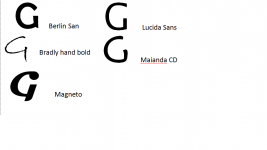J
J&K Tutoring
Guest
My Chinese students are being taught a 'new' upper case letter G. It looks like an upper case C with the addition of only a tiny vertical 'leg' at the lower right. Looks nothing like any G I've seen on any keyboard or in print. Doesn't seem to come up in a Google search or Google images either.
1. Is there a name for this thing or for the boob who thought it necessary to 'fix' the letter G?
2. Similar problem with upper case Q: Students are forced to very carefully start the diagonal leg from the edge of the circle, rather than simply crossing it.
1. Is there a name for this thing or for the boob who thought it necessary to 'fix' the letter G?
2. Similar problem with upper case Q: Students are forced to very carefully start the diagonal leg from the edge of the circle, rather than simply crossing it.
